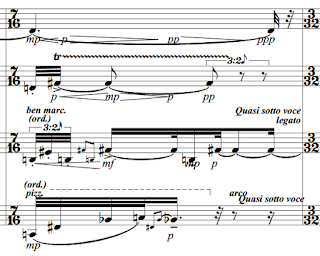"Empfindsamkeit" started off as a commission from Christopher Redgate. His idea was to write a piece for his Oboe Quintet to appear on an upcoming CD. Unfortunately, it wasn't finished in time for the recording. However, in the extra time that I was permitted, a situation occurred that unwittingly contributed to changing my ideas about my music. Unlike much of the music that I composed around that time, this work was written without much prior organisation. Usually, my work is planned meticulously. Weeks, sometimes months are spent, organising pitch elements and rhythms. No such undertaking for this work. What I heard was virtually what was written down. No more, no less. Instead, I concentrated on the sonorities of the music. I moved my focus from pitch and rhythm to timbre and colour. I also had not written for such a conventional group of instruments. Had it not been for Christopher Redgate, I would not have entertained this particular combination. Nevertheless, I was encouraged by the fact that both Ferneyhough and Dillon have written amazing string quartets.
One thing that needs to be made clear - there is no romantic rekindling of the past. The idea of sentimentality is still too close to music of the romantic period for comfort. This work is intended to heighten the senses; I mean in the same way that Synesthesia, Tetrachromacy or Misophonia (but without the rage - just pure emotion) does. This work, alongside "Adieu", was the beginning of a new phase in my compositional output. Instead of the hectic world of "Damballah" and "Chantefables", it was the colour/timbre conscious serenity of "Adieu" and "Empfindsamkeit" after which there would be a pause of about seven years and a rethink about the next step.
As mentioned before, although their wasn’t much pre-planning, there are tight reins held on the pitch and rhythmic material: throughout this work there is a fixed pitch register(e.g. notes will only appear at a specific positions in the scale). For example, the first nine bars stick almost exclusively to these pitches in the string parts;
 |
| Fixed register .  |
The Oboe part has slightly more freedom. The register is comprised of an octave tetrachords which are dominated by intervals of thirds and fourths. The two lowest octaves are orientated around a ‘C’ natural, the higher around a ’G’ sharp. The first two have a mirroring quality.
A similar process (fixed patterns) occurs where the rhythmic writing is concerned. Each bar either consists of staggered rhythmic cells (e.g the string writing of the first bar) or of a rhythmic decomposition (broken down into tiny cells) of an initial idea:
However, it is the coloristic effects that form the most significant element of this work. It is my intention to create a ‘metallic’ effect by staggering the timbral effects so that the vibrations react with one another. Rather like the natural harmonics effect of orchestral string writing, it is not normally discernible on its own but with a microphone it can be picked up:
 |
| 'Syncopated' timbral effects. |
At the time, this composition didn't appear to be significant to my journey as a composer. However, the long self imposed break afterwards meant that it is important landmark; in terms of the music that came before and the music that came afterwards. It made me realise that to accomplish the desired effects I could only use micro-phoned chamber musicians or the forces of an orchestra and that is the direction that I needed to head towards.


